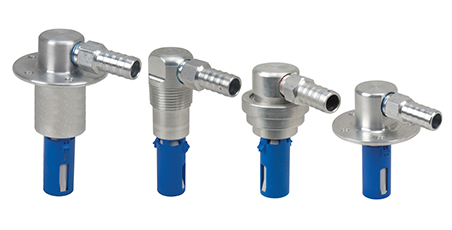Latest Press Releases - Page 3
-

Builders meet regulations with new deflector tank vents
New diurnal emissions regulations state that no water can enter a fuel system's carbon canisters. To help boatbuilders safely comply, Perko has devised two new deflector tank vents. These through-hull units are similar to conventional vents, but incorporate a deflector plate, which makes water infringement less likely. They are intended for applications where certified P-traps are not needed to protect canisters from water.
The new deflector vents are available in straight or 90° models with a black or white polymer splash guard. Both feature 316 stainless steel escutcheons. A removable 30 mesh stainless steel wire screen flame arrestor is included for use with fuel applications. Both the angled and straight versions fit a 5/8" hose with a maximum hull thickness of 5/8".
-

Perko introduces pressure relief valves
Most fuel systems built to meet new emissions requirements are designed and tested to properly vent the tanks under conditions of expected tile angles and temperature changes. But, if a boat owner should overfill a fuel tank, Perko's new Tank Vent Valves with Over Pressure Relief offer protection.
Even if floated closed by fuel, these valves will release any pressure buildup in the tank that exceeds 1 PSI. Perko Tank Vent Valves with Over Pressure Relief are available in three styles to fit specific applications for both plastic and aluminum tanks.
Flanged models are small enough to fit in housings that replicate the SAE level sender flange and bolt patterns. Perko's threaded versions use 1 inch NPTF threads. To ensure proper orientation, swivel valves feature freely rotating hose barbs.
-

PERKO provides valuable emissions training
Builders rely on Perko to provide technically detailed information on emission systems and regulations. To keep its sales reps up to speed, Perko recently conducted the latest of its series of training sessions.
The 3-day seminar focused on Perko's complete line of Diurnal Emissions Control Systems designed to meet EPA and ABYC standards. Topics included updates on new product development, system design, product application, application options and regulatory compliance. Representatives from Perko partners Delphi and Raval provided information about the design, use and installation of their carbon canisters and fuel tank valves.
The classes took place in Perko's +1,000 sq. ft. training facility at its Miami manufacturing plant. Hands-on instruction was aided by examples of nearly a dozen different tank/canister/fuel system configurations, samples of fuel fills, P-traps, vents, ullage tanks, canisters, vapor/fuel separators and fuel system valves.
-

Perko introduces swivel-style fuel tank valves
Ensuring proper alignment when installing fuel tank valves can be a tedious business. Perko has greatly simplified the process easier by adding a swivel feature to its Tank Vent Valves (TVVs), Fill Limit Vent Valves (FLVVs) and Inlet Check Valves(ICVs). All meet upcoming EPA emissions requirements.
These valve assemblies rely on a Viton double O-ring seal and stainless retainer for their versatility. For long wear, receivers and valve bodies are constructed of fire-tested, marine-grade aluminum. For extra strength, receivers are welded to aluminum tanks or molded into plastic tanks. The valve assembly is then simply pushed into the receiver and held in place with a stainless snap ring.
Once installed, the hose barbs rotate freely, eliminating orientation and torque issues. These valves are easily removed and inspected with tools as simple as a pocket knife.
-

Smaller tank vent valves add versatility, cut cost
Small is beautiful when it comes to fuel system components. Providing the same venting capacity as larger units, Perko introduces new, smaller tank vent valves. Almost half the size of previous models, the valves are easier and less expensive to mount, yet breathe just as well.
Three versions are available: flanged, threaded and swivel. Flanged valves are small enough to mount using the same flange diameter and SAE bolt circle as the senders boatbuilders have been using for years. Threaded versions need only a 1" NPT receiver. New swivel models, for aluminum or plastic tanks, rotate freely and seal with a double O-ring. This eliminates mounting orientation and hose torque issues.
The valves' reduced diameter results in a smaller tank cutout, and their lower height requires less clearance space between the fuel tank and deck. With the valves' shut-off point exactly at the top of the tank, 100% of the tank's airspace is available for venting, increasing tank capacity.
